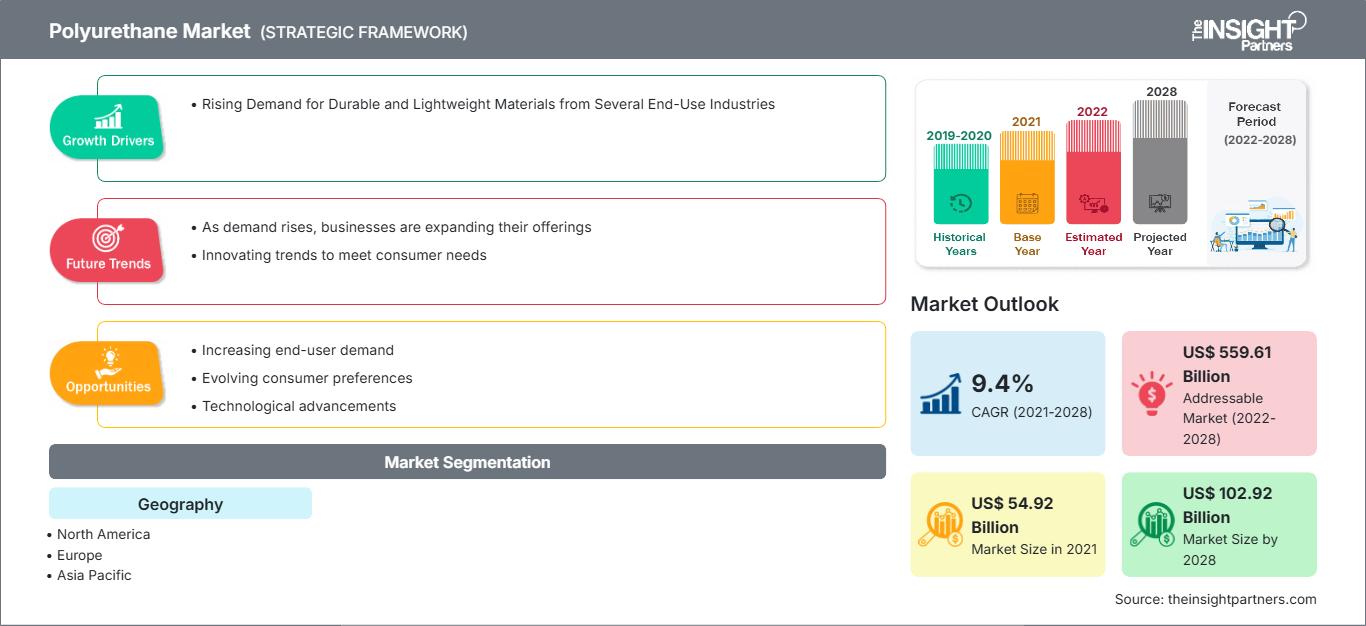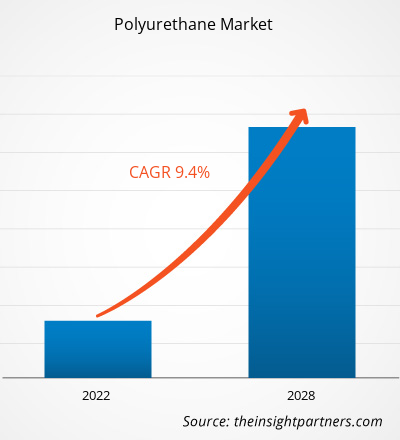[Forschungsbericht] Der Polyurethan-Markt wurde im Jahr 2021 auf 54.917,09 Millionen US-Dollar geschätzt und soll bis 2028 102.916,80 Millionen US-Dollar erreichen; von 2020 bis 2028 wird ein CAGR-Wachstum von 9,4 % erwartet. MARKTANALYSE
Polyurethan ist ein Material, das durch Copolymerisation eines Isocyanats und eines mehrwertigen Alkohols synthetisiert wird. Polyurethan-Verbundwerkstoffe und -Mischungen finden ein breites Anwendungsspektrum in der Elektronik und Optoelektronik. Die Einsatzmöglichkeiten von Polyurethan sind vielfältig und umfassen Sensoren, Elektrolyte, Aktoren, EMI-Abschirmung für Superkondensatoren und Batterien, elektrostatische Ableitung sowie Formgedächtnisanwendungen. Der potenzielle Markt für gedruckte Elektronik ist riesig. PU und seine Verbundklebstoffe finden Anwendung in der flexiblen und gedruckten Elektronik. Polyurethan-Vergussmassen werden von Entwicklern speziell formuliert, um ein breites Spektrum an physikalischen, thermischen und elektrischen Eigenschaften zu erfüllen. Sie können Elektronik schützen, indem sie hervorragende Isolier- und Klebeeigenschaften, außergewöhnlichen flexiblen Schaum sowie Wasser- und Temperaturbeständigkeit bieten.
WACHSTUMSTREIBER UND HERAUSFORDERUNGEN
Die steigende staatliche Unterstützung für die Infrastrukturentwicklung und die weltweit zunehmende Verwendung von Polyurethan als Isoliermaterial haben das Marktwachstum industrieller Polyurethanprodukte gefördert. Regierungen verschiedener Länder auf der ganzen Welt konzentrieren sich auf die Entwicklung der nationalen Infrastruktur. Die Weiterentwicklung der Infrastruktur umfasst Projekte im Zusammenhang mit Straßen, Häfen, Eisenbahnen und Flughäfen, Projekten in der Landwirtschaft und erneuerbaren Energien sowie industrieller und sozialer Infrastruktur. Laut TATA Capital wurde im Haushalt 2020 auch der Infrastrukturausbau vorangetrieben, um Ausgaben für Infrastrukturprojekte in den Bereichen Straßen, Eisenbahnen, Flughäfen, Autobahnen und Häfen zu fördern. Die indische Regierung hat über 1,25 Billionen US-Dollar für Infrastrukturprojekte bereitgestellt und im Rahmen der National Infrastructure Pipeline (NIP) mehr als 6.500 Projekte identifiziert, um bis 2025 eine Volkswirtschaft im Wert von 5 Billionen US-Dollar aufzubauen. Derartige Aktivitäten unterstützen den Bausektor, vor allem in Entwicklungsländern, und werden in den kommenden Jahren reichlich Gelegenheiten für den Polyurethanmarkt schaffen. Die Volatilität der Preise für Rohstoffe, die bei der Polyurethanherstellung verwendet werden, stellt eine Herausforderung für den Polyurethanmarkt dar. Hersteller stellen Polyurethanschaum hauptsächlich durch die Reaktion von Polyolen und Diisocyanaten her und beide Produkte werden aus Rohöl gewonnen. Daher wirkt sich die Volatilität der Rohölpreise letztendlich auf die Produktionskosten von Polyurethan aus. Die internationalen Rohölpreise waren 2020 von Unsicherheit geprägt, und diese setzt sich auch 2021 fort. Sowohl die Nachfrage nach Rohöl als auch die Preise gingen in den ersten Monaten des Jahres 2020 aufgrund von Lockdowns und Reisebeschränkungen in verschiedenen Ländern weltweit stark zurück. Auch die Ölpreise brachen so stark ein, dass der Preis für WTI-Rohöl und der Benchmark für US-Rohöl im April 2020 negativ wurden.
Passen Sie diesen Bericht Ihren Anforderungen an
Sie erhalten kostenlos Anpassungen an jedem Bericht, einschließlich Teilen dieses Berichts oder einer Analyse auf Länderebene, eines Excel-Datenpakets sowie tolle Angebote und Rabatte für Start-ups und Universitäten.
Polyurethan-Markt: Strategische Einblicke

- Holen Sie sich die wichtigsten Markttrends aus diesem Bericht.Dieses KOSTENLOSE Beispiel umfasst Datenanalysen, die von Markttrends bis hin zu Schätzungen und Prognosen reichen.
SEGMENTIERUNG UND UMFANG DES BERICHTS
Sie erhalten kostenlos Anpassungen an jedem Bericht, einschließlich Teilen dieses Berichts oder einer Analyse auf Länderebene, eines Excel-Datenpakets sowie tolle Angebote und Rabatte für Start-ups und Universitäten.
Polyurethan-Markt: Strategische Einblicke

- Holen Sie sich die wichtigsten Markttrends aus diesem Bericht.Dieses KOSTENLOSE Beispiel umfasst Datenanalysen, die von Markttrends bis hin zu Schätzungen und Prognosen reichen.
Die „Globale Marktanalyse für Polyurethan bis 2030“ ist eine spezialisierte und detaillierte Studie mit Schwerpunkt auf globalen Markttrends und Wachstumschancen. Der Bericht soll einen Überblick über den globalen Markt mit detaillierter Marktsegmentierung nach Rohstoff, Produkt, Anwendung und Geografie geben. Der globale Polyurethanmarkt hat in der jüngsten Vergangenheit ein hohes Wachstum erlebt und dieser Trend dürfte sich im Prognosezeitraum fortsetzen. Der Bericht liefert wichtige Statistiken zum weltweiten Polyurethanverbrauch sowie zur Nachfrage in wichtigen Regionen und Ländern. Darüber hinaus bietet der Bericht eine qualitative Bewertung verschiedener Faktoren, die die Marktleistung für Polyurethan in wichtigen Regionen und Ländern beeinflussen. Der Bericht enthält auch eine umfassende Analyse der führenden Akteure auf dem Polyurethanmarkt und ihrer wichtigsten strategischen Entwicklungen. Es sind auch mehrere Analysen der Marktdynamik enthalten, um die wichtigsten Antriebsfaktoren, Markttrends und lukrativen Gelegenheiten zu identifizieren, die wiederum bei der Identifizierung der wichtigsten Einnahmequellen helfen.
Darüber hinaus bieten die Ökosystemanalyse und die Fünf-Kräfte-Analyse von Porter eine 360-Grad-Ansicht des globalen Polyurethanmarktes, die dabei hilft, die gesamte Lieferkette und die verschiedenen Faktoren zu verstehen, die das Marktwachstum beeinflussen.
SEGMENTANALYSE
Der globale Polyurethanmarkt ist nach Rohstoff, Produkt und Anwendung segmentiert. Basierend auf dem Rohstoff ist der Polyurethanmarkt in Polyol, MDI, TDI und andere segmentiert. Auf der Grundlage des Produkts ist der Markt in Hartschaum, Weichschaum, Beschichtungen, Klebstoffe, Dicht- und Bindemittel, Elastomere und andere unterteilt. Der Polyurethanmarkt ist auf der Grundlage der Anwendung in Möbel und Innenausstattung, Bauwesen, Elektronik und Haushaltsgeräte, Automobil, Schuhe, Verpackung und andere kategorisiert. Basierend auf dem Rohstoff hatten Polyole einen erheblichen Anteil. Polyole sind organische Verbindungen mit mehreren Hydroxylgruppen. Sie gehören zu den wichtigsten Rohstoffen bei der Herstellung von Polyurethanen. Methylendiphenyldiisocyanat (MDI) ist eine aromatische Verbindung, die bei der Herstellung von Polyurethan verwendet wird. Es reagiert mit Polyolen zu Polyurethan. Toluoldiisocyanat (TDI) ist eine chemische Verbindung, eine transparente, hellgelbe oder farblose Flüssigkeit. Sie wird zur Herstellung von Polyurethan-Weichschaumstoffen verwendet, die hauptsächlich in Betten und Möbeln, Teppichunterlagen und Verpackungsmaterialien eingesetzt werden. Neben Polyolen und Diisocyanaten werden als Rohstoffe Stabilisatoren und Additive für die Polyurethan-Herstellung verwendet. Gemessen am Produkt hatte Weichschaum den größten Marktanteil. Weicher Polyurethanschaum zeichnet sich durch eine Zellstruktur aus, die eine gewisse Kompression und Elastizität ermöglicht und so für eine dämpfende Wirkung sorgt. Aufgrund dieser Eigenschaft ist er ein beliebtes Material für Möbel, Sportgeräte, Verpackungen, Schuhe, Bettzeug, Autositze und Teppichpolster. Darüber hinaus spielt er eine wichtige Rolle bei der Schalldämmung und Filterung. Polyurethan-Hartschaum gilt als eines der effizientesten und leistungsstärksten Dämmmaterialien. Zudem ermöglicht er sehr effektive Energieeinsparungen bei minimalem Platzbedarf.
REGIONALE ANALYSE
Der Bericht bietet einen detaillierten Überblick über den globalen Polyurethan-Markt in Bezug auf fünf Hauptregionen, nämlich Nordamerika, Europa, Asien-Pazifik (APAC), Naher Osten und Afrika (MEA) sowie Süd- und Mittelamerika. Der Asien-Pazifik-Raum hatte einen erheblichen Anteil am Markt und wurde im Jahr 2022 auf über 9.500 Millionen US-Dollar geschätzt. Die Schwellenländer im Asien-Pazifik-Raum erleben weiterhin einen Aufschwung bei Urbanisierung und Industrialisierung, was den wichtigsten Marktteilnehmern im Polyurethan-Markt reichlich Gelegenheiten bietet. Länder wie Australien, Japan, Indien, China, Südkorea, Singapur, Taiwan und Indonesien haben große Fertigungsindustrien in einem vielfältigen Sektor, darunter Chemie, Textil, Automobil, Elektronik und andere Industrien. Der Fertigungssektor in diesen Ländern hat im Laufe der Jahre einen enormen Wandel erlebt. Nordamerika wird im Jahr 2022 einen Wert von über 3.500 Millionen US-Dollar haben. Der Polyurethan-Markt in dieser Region wächst aufgrund der steigenden Nachfrage aus den Branchen Möbel und Innenausstattung, Bau, Elektronik und Haushaltsgeräte, Automobil, Schuhe, Verpackung und anderen in Nordamerika ansässigen Branchen.
BRANCHENENTWICKLUNGEN UND ZUKÜNFTIGE CHANCEN
Der Bericht bietet einen detaillierten Überblick über den globalen Polyurethan-Markt in Bezug auf fünf Hauptregionen, nämlich Nordamerika, Europa, Asien-Pazifik (APAC), Naher Osten und Afrika (MEA) sowie Süd- und Mittelamerika.
Im Jahr 2021 schloss Covestro die Übernahme des Geschäftsbereichs Harze & Funktionsmaterialien von DSM erfolgreich ab.
Im Jahr 2020 gab die Huntsman Corporation bekannt, dass sie ihr weltweit führendes Geschäft mit Sprüh-Polyurethanschaum (SPF) als Huntsman Building Solutions (HBS) firmiert. HBS ist eine globale Plattform innerhalb der Polyurethan-Sparte von Huntsman.
PolyurethanRegionale Einblicke in den Polyurethanmarkt
Die Analysten von The Insight Partners haben die regionalen Trends und Einflussfaktoren auf den Polyurethan-Markt im Prognosezeitraum ausführlich erläutert. In diesem Abschnitt werden auch die Polyurethan-Marktsegmente und die geografische Lage in Nordamerika, Europa, Asien-Pazifik, dem Nahen Osten und Afrika sowie Süd- und Mittelamerika erörtert.
Umfang des Polyurethan-Marktberichts
| Berichtsattribut | Einzelheiten |
|---|---|
| Marktgröße in 2021 | US$ 54.92 Billion |
| Marktgröße nach 2028 | US$ 102.92 Billion |
| Globale CAGR (2021 - 2028) | 9.4% |
| Historische Daten | 2019-2020 |
| Prognosezeitraum | 2022-2028 |
| Abgedeckte Segmente |
By Geographie
|
| Abgedeckte Regionen und Länder | Nordamerika
|
| Marktführer und wichtige Unternehmensprofile |
|
Dichte der Marktteilnehmer im Polyurethan-Markt: Verständnis ihrer Auswirkungen auf die Geschäftsdynamik
Der Polyurethan-Markt wächst rasant, angetrieben durch die steigende Endverbrauchernachfrage aufgrund von Faktoren wie sich entwickelnden Verbraucherpräferenzen, technologischem Fortschritt und einem stärkeren Bewusstsein für die Produktvorteile. Mit steigender Nachfrage erweitern Unternehmen ihr Angebot, entwickeln Innovationen, um den Verbraucherbedürfnissen gerecht zu werden, und nutzen neue Trends, was das Marktwachstum weiter ankurbelt.

- Holen Sie sich die Polyurethan-Markt Übersicht der wichtigsten Akteure
Der Bericht bietet einen detaillierten Überblick über den globalen Polyurethan-Markt in Bezug auf fünf Hauptregionen: Nordamerika, Europa, Asien-Pazifik (APAC), Naher Osten und Afrika (MEA) sowie Süd- und Mittelamerika. Branchen wie die Bau-, Automobil-, Elektronik- und Möbelindustrie sind die größten Verbraucher von Polyurethan. Im Jahr 2020 mussten diese Branchen ihre Betriebsabläufe aufgrund von Störungen in der Wertschöpfungskette drosseln, die durch die Schließung nationaler und internationaler Grenzen verursacht wurden. Darüber hinaus beeinträchtigten von verschiedenen Ländern verhängte Lockdowns die Fähigkeit der Branchen, im selben Jahr ihre Lagerbestände aufrechtzuerhalten. Der Mangel an Arbeitskräften führte zu einer Verlangsamung der Polyurethan-Produktion und -Verteilung. Darüber hinaus verringerten staatliche Beschränkungen und andere COVID-19-Vorkehrungen die Produktionskapazitäten der Beteiligten im Polyurethan-Ökosystem. Im Jahr 2021 begann sich der globale Markt von den Verlusten des Jahres 2020 zu erholen, als Regierungen verschiedener Länder Lockerungen der sozialen Beschränkungen ankündigten. Darüber hinaus wird erwartet, dass die zuvor verschobenen Bauprojekte wieder aufgenommen werden, was den Akteuren auf dem Polyurethan-Markt die Möglichkeit bietet, zur Normalität zurückzukehren. Der Ausbau der Produktionskapazitäten in der Chemie- und Werkstoffindustrie in verschiedenen Regionen der Welt führte 2021 zu einem Anstieg der Nachfrage nach Polyurethan.
WETTBEWERBSLANDSCHAFT UND WICHTIGE UNTERNEHMEN
Zu den wichtigsten Akteuren und führenden Polyurethan-Herstellern auf dem Polyurethan-Markt gehören unter anderem Covestro AG, FXI, Huntsman Corporation, Lubrizol Corporation, Mitsui Chemicals Inc, BASF SE, The Dow Chemical Company, DIC Corporation, Recticel NV und Tosoh Corporation.
- Historische Analyse (2 Jahre), Basisjahr, Prognose (7 Jahre) mit CAGR
- PEST- und SWOT-Analyse
- Marktgröße Wert/Volumen – Global, Regional, Land
- Branchen- und Wettbewerbslandschaft
- Excel-Datensatz
Aktuelle Berichte
Erfahrungsberichte
Grund zum Kauf
- Fundierte Entscheidungsfindung
- Marktdynamik verstehen
- Wettbewerbsanalyse
- Kundeneinblicke
- Marktprognosen
- Risikominimierung
- Strategische Planung
- Investitionsbegründung
- Identifizierung neuer Märkte
- Verbesserung von Marketingstrategien
- Steigerung der Betriebseffizienz
- Anpassung an regulatorische Trends




















 Kostenlose Probe anfordern für - Polyurethan-Markt
Kostenlose Probe anfordern für - Polyurethan-Markt